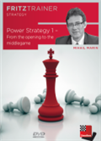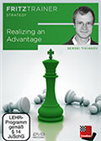Sadler on Books
Reproduced with kind permission of New In Chess magazine
 December was an important chess month for me: I was playing my first big tournament of the year, taking part in the British Knockout Championship held parallel to the fantastic London Classic. My enthusiasm for playing is somewhat variable, but I always find preparing myself for a big tournament to be a fascinating experience. By this I don’t mean opening preparation – which, to be frank, is a necessary evil and, rather depressingly, rarely feels like it helps to improve your chess — but rather the process of ensuring that all the components of your game — mental and technical — are functioning smoothly by the time the tournament starts.
December was an important chess month for me: I was playing my first big tournament of the year, taking part in the British Knockout Championship held parallel to the fantastic London Classic. My enthusiasm for playing is somewhat variable, but I always find preparing myself for a big tournament to be a fascinating experience. By this I don’t mean opening preparation – which, to be frank, is a necessary evil and, rather depressingly, rarely feels like it helps to improve your chess — but rather the process of ensuring that all the components of your game — mental and technical — are functioning smoothly by the time the tournament starts.
One of the strange things about competition is how much of your life is dedicated to repetition. With experience, you gain understanding of the parameters you require to play optimal chess: the mood you want to be in, the skills you want to have activated before the tournament (tactics, knowledge of typical endgames, ability to reason). In time, every player develops a preparation routine for tournaments that he works through, just as he has for the tournament before that, and the tournament before that... And yet, frustratingly, getting yourself into form isn’t as simple as just working through a set of standard exercises. As a professional, I started keeping notes of the important thoughts I’d had while preparing for tournaments, hoping that the next time I could just quickly read my notes and skip all that laborious thinking. It failed miserably of course: there’s a living, breathing part to being in form that you only get by actively taking part in a process of preparation. Reading passively about past experiences doesn’t spark any life at all in you.
So... the puzzle of preparation is as follows: you need to follow a process to ensure that the pieces of your game that you need to play well, fall into place at exactly the right time. You want the result to be repeatable, but... the process can’t be routine: it must fire your imagination and bring your thoughts to life. Designing that process for each tournament is the interesting bit! Nowadays, time for chess being rather limited, I try to combine business with pleasure by preparing for tournaments by reading books (and thus writing this column at the same time ☺). So what did my preparation for this tournament look like? Well, read on!
Master Class Vol. 9: Paul Morphy
 Learn about one of the greatest geniuses in the history of chess! Paul Morphy's career (1837-1884) lasted only a few years and yet he managed to defeat the best chess players of his time.
Learn about one of the greatest geniuses in the history of chess! Paul Morphy's career (1837-1884) lasted only a few years and yet he managed to defeat the best chess players of his time. ... I turned to the Chessbase DVD
Master Class Vol. 9: Paul Morphy for some inspiration from the olden days of chess. I’m very fond of this series. Each DVD treats a different classic player and contains lectures from IMs or GMs on this player’s treatment of the opening and middlegame as well as a series of puzzles taken from this player’s attacks and endgames. Oliver Reeh and Karsten Müller are the core team for tactics and endgames and always do an excellent job (this DVD is no different). I confess though that my decision to buy the DVD depends on whether Mihail Marin is doing the middlegame section. I was intrigued to learn what Marin would discover in Morphy’s middlegame play. Many moons ago, I remember GM Chris Ward — while writing a book on Morphy — bemoaning the difficulty of drawing lessons from Morphy’s play due to the large number of odds games and the dubious level of many of his opponents. Once again however, Marin comes up trumps. He picks out five games of Morphy, none of which were familiar to me, and his treatment of four of these — two games from his 1858 match against Harrwitz, a consultation game against Staunton and the last game of his 1858 match against Adolf Anderssen — is stunning. I particularly enjoyed his examination of the two blocked Dutch defences against Harrwitz:
Marin’s analysis of these games works on several levels. Firstly, I found his thoughts on these types of blocked positions to be interesting in themselves. Secondly, he does an excellent job of conveying the logic and purpose of Morphy’s play (especially striking in such difficult strategical positions) even when pointing out mistakes or inaccuracies in his play. I ended the series of lectures with a heightened respect for both Morphy and Marin!
Order Master Class Vol 9.: Paul Morphy in the NiC Shop
Power Strategy 1
 The first DVD deals with the initial phase of the game, when the all the reigning principles can be crystalized into just one: DEVELOPMENT!
The first DVD deals with the initial phase of the game, when the all the reigning principles can be crystalized into just one: DEVELOPMENT!While hunting around the ChessBase shop, I also ran into another couple of DVD’s that caught my fancy. Ideally, preparing for a tournament would also improve your chess skills in some way. That’s why I resent preparing openings for tournaments, because most of that time is spent revising your lines and trying to remember what you wanted to play, which never feels particularly useful in the long term (I’ll forget them again within a few weeks anyway!). Watching a DVD like Power Strategy 1 by Mihail Marin does give you the feeling of improving as you watch. The goal of this series is to examine general rules in chess. In this DVD, Marin takes the concept of development in the opening and the transition to the middlegame and examines a whole range of issues associated with this. For example, a player deviates from natural development and is punished for it, developing sacrifices (in which Tal features heavily as you would expect!) and the tactical benefits of being well-developed.
At the risk of sounding like a Marin groupie, this is such a good DVD! The very first game captures your imagination and sets the scene beautifully for the rest of the DVD. It’s a game Ivkov-Gheorghiu, Buenos Aires 1979. Marin describes that he first saw this game when he was 14 and it made a huge impression on him. Both his favourite opening variation and a hero of Romanian chess were defeated in very impressive fashion. The game started promisingly as Gheorghiu came up with a stunning idea for counterplay in a typical Romanian variation:
I liked very much how Marin later brought in a game by Tal against Vladimirov that contains echoes of this one:
Same structure... different result though. But well... Black is Tal. Here he made the developing move 16...♗xh3! and Black won a brilliant attacking game.
In conclusion, definitely the best examination out there of the problems and challenges of development in the early stages of the game. 100% recommended!
Order Power Strategy 1: From the opening to the middlegame in the NiC Shop
Realizing an Advantage
 It’s a problem every player encounters when he stands better in a game: how to convert his plus into a full point? In this DVD the author answers this difficult question of chess strategy, considering both the psychological aspects of the realisation of an advantage and the technical methods.
It’s a problem every player encounters when he stands better in a game: how to convert his plus into a full point? In this DVD the author answers this difficult question of chess strategy, considering both the psychological aspects of the realisation of an advantage and the technical methods.Another one of my favourite ChessBase authors — Sergei Tiviakov — also brought out a new DVD entitled Realizing an Advantage, a continuation of his series on strategy which until now has covered The Art of Defence and The Art of the Positional Exchange Sacrifice. The core of the DVD is comprised of 20 videos, divided up into different techniques of realising an advantage such as ‘converting one type of advantage into another’ and ‘how to exploit 2 weaknesses’. One of the features of Tiviakov’s instructional DVD’s that most appeals to me is the standard format he uses: he introduces each theme with a classical game — he makes heavy use of the games of his heroes Karpov, Smyslov and Petrosian — and then presents some of his own games where he applied the technique he has just described. I find this approach works very well for me. I find classic games much easier to remember than modern games (possibly due to the aura of the names involved, possibly because classic games are normally slightly simpler than modern games), so these become my blueprints for practical play. However, I also find the examples of classic themes being applied in modern games very motivational: if they can do it, so can I! Tiviakov’s delivery in English is sometimes rather stilted, but he compensates for this by the excellent organisation of his material and the clarity of his examples. I felt I learned a lot!
Order Sergei Tiviakov: Realizing an Advantage: FritzTrainer Strategy in the NiC Shop

The above review appeared in the 2018 #1 edition of New in Chess magazine.
New In Chess (NIC) was founded in 1984 and appears eight times a year. Dirk Jan ten Geuzendam is the editor-in-chief.
Besides on-the-spot tournament reports, interviews, chess training and historical articles, the magazine’s hallmark are game comments by the world’s leading players, such as Magnus Carlsen, Vladimir Kramnik, Wesley So, Levon Aronian, Fabiano Caruana, Vishy Anand, Hikaru Nakamura, Maxime Vachier-Lagrave, Anish Giri, Judit Polgar and many others.
It is read by club players in 116 countries. A yearly subscription for eight issues costs €79.99 and can be ordered here.
Links


















 December was an important chess month for me: I was playing my first big tournament of the year, taking part in the British Knockout Championship held parallel to the fantastic London Classic. My enthusiasm for playing is somewhat variable, but I always find preparing myself for a big tournament to be a fascinating experience. By this I don’t mean opening preparation – which, to be frank, is a necessary evil and, rather depressingly, rarely feels like it helps to improve your chess — but rather the process of ensuring that all the components of your game — mental and technical — are functioning smoothly by the time the tournament starts.
December was an important chess month for me: I was playing my first big tournament of the year, taking part in the British Knockout Championship held parallel to the fantastic London Classic. My enthusiasm for playing is somewhat variable, but I always find preparing myself for a big tournament to be a fascinating experience. By this I don’t mean opening preparation – which, to be frank, is a necessary evil and, rather depressingly, rarely feels like it helps to improve your chess — but rather the process of ensuring that all the components of your game — mental and technical — are functioning smoothly by the time the tournament starts.





